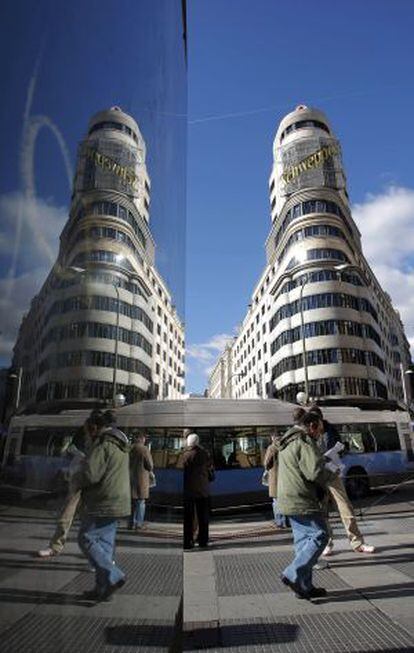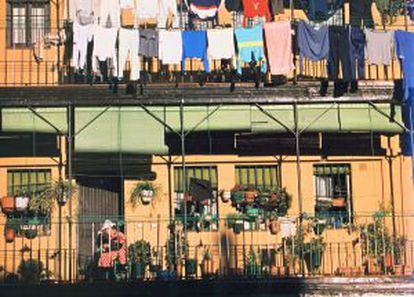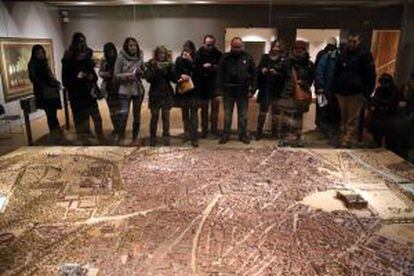Madrid, frame by frame
A group of French students is analyzing the changing capital through the movies

Opposite No. 72 Gran Vía in the heart of downtown Madrid a group of young people, all aged around 25, enters an enormous building. “Isn’t this where they filmed the escape and fight sequence in The Day of the Beast?” asks a girl with a light French accent. Jesús Rodríguez takes out his tablet computer and, to confirm it, shows her a sequence of Alex de la Iglesia’s fantasy action comedy in which they can see the same enormous building and same imperial staircase.
Jesús is one of the volunteers who responded to a request from 10 Bordeaux students preparing for l’agrégation, France’s highly selective government exams, to become teachers of Spanish culture. Last November the students read in EL PAÍS that the Madrid, Ciudadanía and Patrimonio (Madrid, Residents and Heritage — MCyP) association was organizing a tour of the capital and wrote to ask if they would be able to organize something similar for them based on their exam topic for this year of “Madrid interpreted through its cinema.”
“Oui, oui,” was the response from the MCyP and the students got down to spending their Christmas watching the films shot in Madrid that the French Ministry of Education had selected, even going so far as to create a map and a 53-page report on all the film locations.
They all knew the famous scene from De la Iglesia’s film where the main characters run away from the Beast, suspended from the Schweppes sign on the Capitol building in Plaza de Callao. But today they find out that all the scenes that pretend to be inside the Capitol were in fact shot in another Gran Vía building, Casa Matesanz. As well as locating the building and asking permission to go inside, the volunteers make the most of every scene to talk about Madrid, mixing personal and historical anecdotes. “The mountaineering club was here — where I used to come when I was younger. But then I wasn’t so interested in our heritage,” says Jesús, smiling, before going on to explain that it was built in the 1920s by the Matesanz brothers. It was one of the city’s first American-style shopping malls.

Movies also serve to highlight some of Madrid’s hidden treasures. Few locals know that the municipal museum houses one of the oldest and most historically important models in Europe: commissioned by Ferdinand VII, the model of Madrid there was created in 1830 by Gil Palacio and appears in the first minutes of Basilio Martín Patino’s Madrid. The main character, a director, is seen trying to understand the city because he is making a documentary about it. In exactly the same way, the students put themselves in the shoes of the director and look at the city both in its totality and in its most minute detail.
Other stop on the route, another atmosphere: the Chamberí ghost metro station that features in Fernando León de Aranoa’s 1998 Barrio. They know the dialogue almost by heart. “If it’s a ghost station, there will be ghosts, right?” asks one of the three teenage leads.
“Ghosts don’t exist, you idiot. It’s because they closed it a long time ago,” answers another, before they head off exploring down the tunnels and bump into some homeless people sheltering there.
The vagrants have been gone since 2008 when the space became a museum preserving treasures of the station as it was when it closed around 1960 after it was deemed too close to another one.
Some of the older films, such as Nieves Conde’s Surcos (1951), help to imagine places that no longer exist, such as the Plaza de San Ildefonso market. Thanks to the movies, the students can almost hear the hustle and bustle of one of Madrid’s oldest covered markets and the temporary stalls spread out around the surrounding streets.

“Certain buildings disappear, but their inhabitants go on living and tell their stories; that is also the memory of Madrid,” says Marte Ruiz, another volunteer from the association as they pass by the corrala [one of the typical Madrid tenements comprising galleries set around a courtyard] on Calle de Mesón de Paredes. “I give Spanish classes in the corralas and they tell me about a tough existence, but they also say they got on with life, and did so together, with a community spirit. They made lemonade, they brought out chairs...”
The students knew about the corralas and this one in particular from Surcos. In one of the first scenes in the film, a family arriving from the country reaches the house of a relative inside the corrala, who charges them to sublet one of the rooms. After multiple ups and downs and nearly being demolished, the building has now been declared a national monument, says one of the volunteers.
This week Madrid and Bordeaux celebrated 30 years as sister cities, an accord that now goes beyond the borders of institutions. The association and the students organized the route independently, inspired by their passion for the city and its cinema. The students have their exams at the end of March and if they pass, dream about their next trip to Madrid — this time as qualified teachers.










































